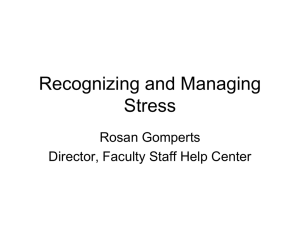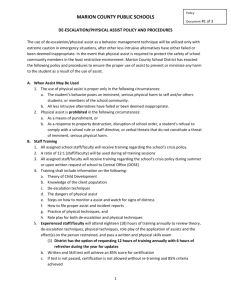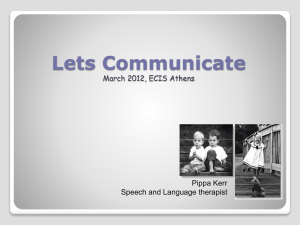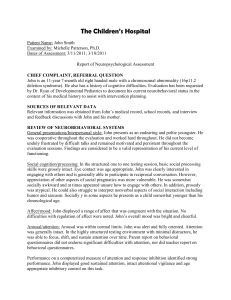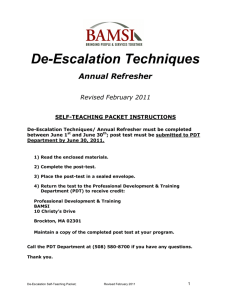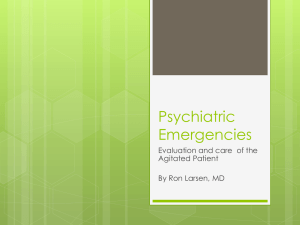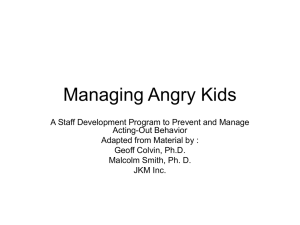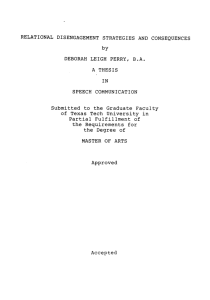- WhatDoTheyKnow
advertisement
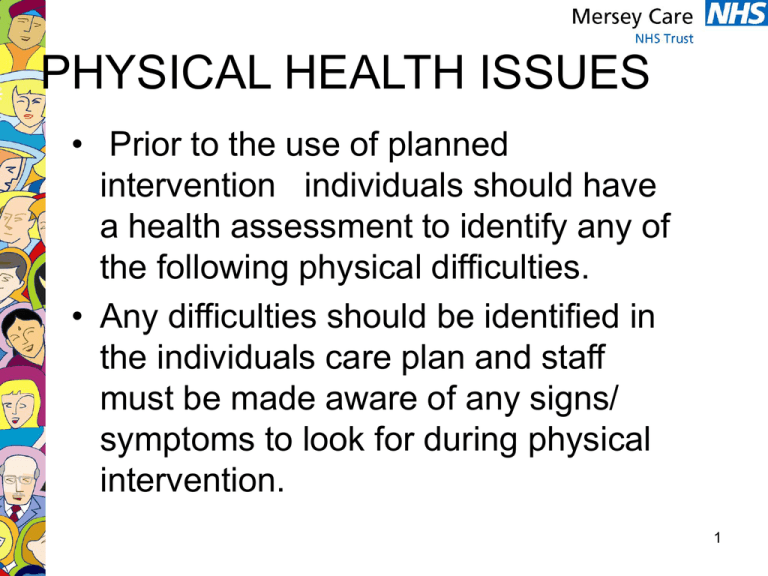
PHYSICAL HEALTH ISSUES • Prior to the use of planned intervention individuals should have a health assessment to identify any of the following physical difficulties. • Any difficulties should be identified in the individuals care plan and staff must be made aware of any signs/ symptoms to look for during physical intervention. 1 PRIOR TO THE USE OF PHYSICAL INTERVENTION • • • • • • • • • Asthma/ breathing difficulties Hemiplegia/ skeletal abnormalities Recent fractures Recent dislocations (fingers, elbows,etc) Epilepsy Vomiting Arthritis/oesteo- arthritis Pregnancy Heart conditions 2 During the use of physical intervention • • • • • • Breathing difficulties/rapid breathing Seizures Fractures Dislocations Cyanosis/ mottling of skin During the use of physical intervention staff must observe for signs of medical emergencies if these occur medical advice must be sought 3 COMMUNICATION DIFFICULTIES • • • • • • Deafness Blindness Poor verbal speech Poor comprehension skills Long hair Ensure you take into consideration communication difficulties when restraint is used, use alternative support systems such as signing pictures or modelling 4 The Effects of violence • Physical assault can cause staff physical effects. But psychological effects can be equally disabling. Delayed manifestations can include: • Sleep disturbance • Tearfulness • Irritability • Loss of concentration 5 POST INCIDENT MANAGEMENT • Following an incident of physical intervention, staff & service users should be given separate time to talk about what happened in a safe environment. • Post incident interviews should be designed to find out what happened & the effects on the participants, not to apportion blame. • (Department of Health 2002) 6 Rules To Debriefing • It should not be time limited • What you say should be valued • Its not about what you did wrong its about feelings • It should be confidential • It should be conducted in a safe environment • Managers need to debrief too!!! O'Neill (unpublished) 7 De-escalation: definitions • De-escalation refers to a set of verbal and non-verbal responses which, if used selectively and appropriately, reduce the level of a person’s hostility by reducing anger and the predisposition to assaultative behaviour. (Turnbull et al,1990) • The concept of de-escalation should be applied in a broader sense to encompass the role of the organisation, including its culture organisation policies and procedures (Leadbetter & Patterson, 1995) 8 NON-VERBAL CUES AND EARLY WARNING SIGNS •Invasion of ‘personal space’ - coming too close •Increased volume of speech •Replicating earlier violent episodes •Prolonged eye contact •Verbal threats or gestures •Increased or prolonged restlessness body tension •Facial expressions tense and angry •Blocking of escape routes •Reporting violent feelings 9 Stages in a Violent Episode; an Affective Model Phase 3 Crisis Phase 2 Escalation Phase 1 Triggering Phase 4 Recovery Stable Base Line Phase 5 Depression TIME • Observe •De-escalate • Inform •Contain • Remove •Anticipate • Wait • Reassure • Plan Prevent and Support Trigger Kaplan & Wheeler, 1983 10 Instrumental Model of Aggression Choice of violence Choice of victim Choice of Violence type Choice of timing NB Opportunistic behaviour Choice of Location Stable Base Line Stable Base Line TIME Patterson & Miller 2005 11 Managing your own emotions Before you can control a situation you need to be able to control yourself • Recognise and acknowledge signs of anxiety – E.g. fight/flight/freeze, adrenaline responses • Recognise danger signals of your own & others anger – E.g. raising voice, clenching fist, bracing shoulders • Take one deeper than normal breath / exhale slowly • Use positive self statements e.g. ‘I can cope’ if you feel your anxiety levels are increasing • Perhaps withdraw temporarily ‘time out’ ! ! • Count to ten ! 12 De-escalation: Non Verbal Aspects Stance Posture Space Eye contact Touch Facial expression Pitch/tone/volume Environment Hand gestures Escape/withdraw Active listening Stay calm Control breathing 13 De-escalation: Verbal Skills Steady, calm, even tone Don’t react with agitation Empathy Avoid jargon Don’t make promises Be honest Be yourself Personalise Concise language Don’t argue/challenge Positive words/phrases Reflect/paraphrase Clarify the problem Avoid terms of intimacy Avoid boundary words Ask open questions Be assertive 14 Interpersonal strategies 15 Strategies of Engagement Competing Collaborating Compromising Avoiding Accommodating Co-operation Thomas (1975) 16 Interpersonal strategies • Depersonalise the issue • Personalise yourself • Empower the person • Make a token concession • Make a deliberate friendly gesture • Using “we” • Using diversions (Davies & Frude, 2002) 17










